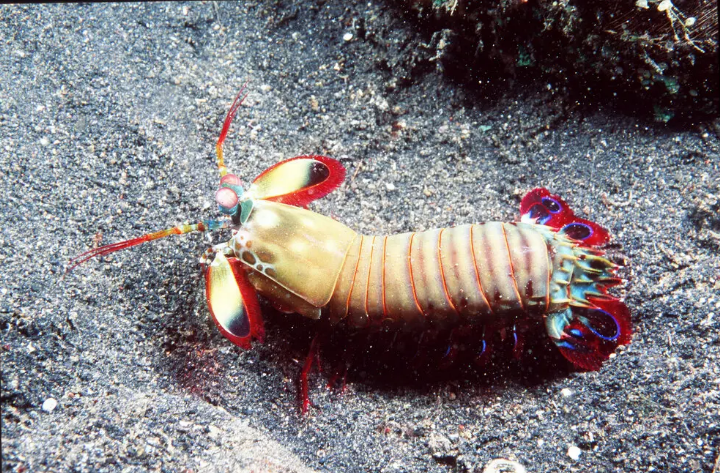我们通过发表论文来表彰学生 STEM 写作比赛的前 11 名获奖者。这是苏莱曼·穆罕默德(Suleiman Mohamed)的作品。

。。。斯图尔特·威斯特摩兰/照片研究人员公司
这篇文章由来自阿曼马斯喀特马斯喀特英国学校的 16 岁的 Suleiman Mohamed 撰写,是学习网络第二届年度 STEM 写作比赛的前 11 名获奖者之一,我们收到了 3,741 份参赛作品。
The Peacock Mantis Shrimp: The Ant-Man of Atlantis
Fifty miles per hour. A force of 8,000 G’s. All deployed in under two milliseconds. You’re not looking at a modern-day bullet, but the fastest punch in the animal kingdom.
Dubbed by scientists as “nature’s underwater marvel,” the peacock mantis shrimp has the ability to pierce its prey’s skull and completely cavitate the water around it. However, as fascinating as that sounds, the question still remains: How can this four-inch creature deliver forces 1,000 times its own weight?
In typical fashion, nature doesn’t like to reveal all its secrets, but scientists around the world have managed to attribute this mystery to one factor: its structure. While most man-made materials have their atoms layered on top of each other in an orderly fashion, this shrimp’s club takes a page out of nature’s cookbook by layering its fibers in small varying degrees, forming a spiral-like helicoid structure, capable of withstanding over 2,000 Newtons of force!
Split into three main layers, its club is purpose-built to pack a powerful punch every time. The first layer is composed of a mineral known as hydroxyapatite, the same one found in your hair and teeth; however, in this case, it’s in a more crystalline form, owing to a much harder surface. The second layer is composed of a much softer form of the same mineral albeit with each layer being rotated slightly, forming the helicoid structure that scientists have now come to recognize. The third consists of layers of chitin that prevent the club from expanding upon impact.
But what if we were to implement this into the mainstream market? While scientists and engineers have known about this phenomena for more than half a decade, the research originally conducted by the University of California, Riverside, in 2014 is just starting to trickle down into various corporations. The most complex architecture used in the aerospace industry today revolves around layering sheets of carbon-fiber at zero degrees, 45 right, 45 left and then 90 degrees. However, if we were to layer the same material using a helicoid configuration, the results would be borderline revolutionary!
This would delay internal failure by over 74 percent, increase impact resistance by over 50 percent and improve load-bearing by over 92 percent. Now, you don’t need to be a rocket scientist to understand that those figures can reform entire industries.
However, while figures are one thing, real-life performance is a whole different situation, and it doesn’t fall short. This extraordinary structure allows for much lighter, stronger and cheaper composites, which, when implemented into vehicles, allows them to emit less carbon dioxide and carry a smaller carbon footprint. And while our world is hanging onto life support, this could be the very turning point at which we can make a significant change.
As scientists continue to pluck from the fruits of nature, this discovery merely marks the beginning of a whole new wave of materials to come. From hummingbirds to geckos, we are finally turning a new leaf, falling toward the mystic arts of nature rather than trying to cast away its spells.
Works Cited
Kim, Meeri. “Shrimp’s Shell-Smashing Punch Hands Researchers a Lead on Tougher Materials.” The Guardian, 9 May 2014.
Kwok, Roberta. “This Shrimp Packs A Punch.” Science News, 27 March 2013.
News Channel 3 Staff. “The Mantis Shrimp Changing Composites.” News Channel 3, 19 Nov. 2019.
Scharping, Nathaniel. “How Mantis Shrimp Punch So Hard Without Hurting Themselves.” Discover, 16 Jan. 2018.
Science Daily Staff. “Mantis Shrimp Stronger Than Airplanes.” Science Daily, 22 April 2014.
Treacy, Siobhan. “Materials for Aerospace and Sports Inspired by the Mantis Shrimp’s Club.” Engineering360, 16 Jan. 2018.